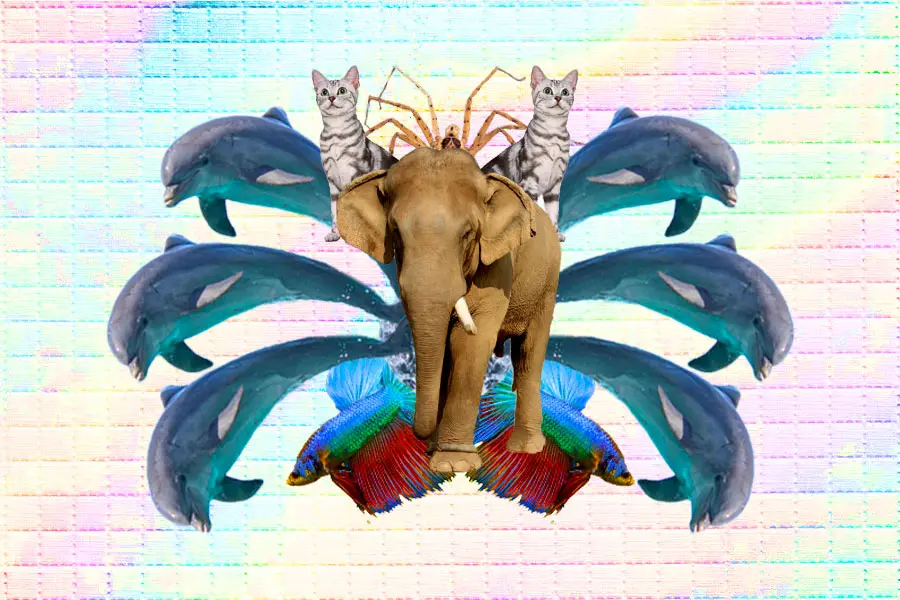Hippies and other early psychonauts weren’t the only ones dropping acid back in the Sixties and Seventies. Several animals also had the experience of dabbling with LSD, courtesy of the scientists who wanted to see what effects it would have on various species. The results of those tests ranged from bizarre to tragic. Here’s what happened when scientists gave acid to dolphins, cats, fish, spiders and an elephant.
A Traumatized Dolphin Trusted Humans Again
Dolphins are among the animals who benefited from taking LSD.
The dolphin acid tests were conducted in the mid Sixties by the late neuroscientist John C. Lilly, a Dr. Doolittle-meets-Jerry Garcia type of character, who was passionate about both experimenting with LSD and trying to communicate with dolphins.
To Lilly’s delight, upon injecting dolphins with LSD, he found that it made the marine mammals much more chatty than usual. He also found that it helped one of them overcome serious psychological trauma: Years earlier, that dolphin had been shot through the tail with a spear gun. As a result, it refused to go near human beings again. “In our pool she would stay on the far side away from anybody that was there,” Lilly said during a presentation at the Second International Conference on the Use of LSD in Psychotherapy in 1965. “If you tried to approach her, she would shoot away from you.” That changed once Lily dosed the dolphin with acid.
Read: Could Giving Acid to Dolphins Help Us Talk To Aliens?
“As the LSD effect came on…the dolphin came over to me,” Lilly explained. “She had not approached me before. She stayed still in the tank with one eye out of water looking me in the eye for ten minutes without moving. This was a completely new behavior. I moved around to see if there would be any effect from my movements. She followed me right around the edge of the tank. I moved out of the room, and the assistant moved into position. The same behavior continued.”
That pleasant side effect of the experiment lasted even long after the acid wore off. “She will now come within five feet of me instead of staying twenty feet away,” Lilly added. “It is a very amazing change in behavior.”
Lilly’s findings have since been backed up by current psychedelic studies, which have found that LSD is an effective treatment for PTSD and other psychological conditions.
How to Grow Shrooms Bundle
Take Both of Our Courses and Save $90!
Cats Became Afraid of Mice
Acid doesn’t appear to have any medicinal benefits for cats, but it can help mice sleep a bit easier. That’s because LSD makes felines indifferent to mice—or even afraid of their prey.
“[I]nstead of attacking the mouse, the cat leaves it alone or will even stand in fear before the mouse,” Albert Hofmann, the Swiss scientist who discovered acid, noted in his 1980 memoir LSD—My Problem Child.
Hofmann wasn’t the only researcher interested in the effects of acid on cats. In the 1970s, Barry Jacobs, a professor at the Princeton Neuroscience Institute, began studying the biological process of hallucination by giving LSD-infused water to his lab cats.
The spiked water hit the whiskered test subjects like a potent dose of catnip. “Some of them ran around like crazy people, bounding around,” Jacobs told VICE in 2014. When they weren’t racing around, the cats often “stared for long periods of time” as if they were hallucinating.
Since cats can’t talk, there was no way of telling if they were actually hallucinating, let alone if they were having a good or bad trip, but Jacobs believes that the felines enjoyed the experience.
“[N]one of them seemed fearful,” he explained. “What a typical fearful cat would do is crawl into the back of the cage. They were really bounding around as opposed to having behaviors that looked fearful.”
The cats also flicked and licked their paws excessively, which Jacobs read as another sign that they were tripping.
“Maybe—and this is a guess—maybe [that was caused by an] increased sensitivity to their paws. That is, they felt something crawling on their paws, which would be very consistent with a hallucinatory-like interpretation.”
So if your cat starts grooming itself a hundred times in an hour, you might want to check your stash.
Tropical Fish Swam Backwards
Like cats, a certain breed of tropical fish is known to get rambunctious when given LSD. In 1954, Harold Abramson, a physician who was involved in the CIA’s MK-Ultra program (the government’s clandestine LSD experimentation), and Llewellyn Evans, a researcher at the Cold Spring Harbor Laboratory, dosed several Siamese fighting fish with LSD. Shortly afterward, the test subjects began hanging around the top of their tanks in a vertical instead of horizontal position (i.e. with their noses pointed upward and their tails pointed toward the bottom of the tank). As if that wasn’t strange enough, the fish also started doing barrel rolls and even swam backwards while the researchers watched in astonishment.
Abramson and Evans weren’t sure why their fighting fish began swimming strangely, but the behavior seems to be peculiar to that species. In 1963, a team of researchers did a followup study that involved giving LSD to 30 different types of tropical fish. They found that fighting fish were the only species that did barrel rolls after ingesting acid.
As with all animals, there’s no way of knowing if these fish were having a full-blown psychedelic experience or if LSD simply made their nervous systems go haywire, but the sight of them swimming backwards probably made the researchers feel like they were indeed having a psychedelic experience.
Spiders Spun Better Webs
Acid isn’t nearly as disorienting for spiders as it is for fighting fish. In fact, a small dose can help spiders spin better webs according to German pharmacologist Peter Witt. In 1948, Witt infused droplets of sugar water with LSD and gave the solution to some thirsty orb spiders. He found that in low doses, LSD helped the arachnids build webs that were far more symmetrical than usual. High doses, however, resulted in sloppy webs (so perhaps you could say that spiders are one of the first species to benefit from microdosing).
Witt’s findings aren’t as strange as the basis for his research project. While every other experiment on this list was grounded in the pursuit of knowledge, Witt’s study was launched to make life easier for a colleague.
In low doses, LSD helped the arachnids build webs that were far more symmetrical than usual. Perhaps you could say that spiders are one of the first species to benefit from microdosing.
In the late 1940s, German zoologist Hans Peters wanted to film a documentary on the process of web-spinning. Only problem was, most orb spiders construct their sticky traps early in the morning (after 2 AM), which didn’t work well with Peters’ busy schedule. Instead of pulling a few all-nighters, Peters asked Witt to give the spiders something to make them spin webs at a decent hour.
Witt tried coffee, benzedrine, marijuana and other substances to tweak the spiders’ routine, but nothing worked. But the study did offer many insights into how orb spiders tick and produced some truly strange webs (which you can see here).
An Elephant Became a Cautionary Tale
If hearing about animals tripping out is giving you any ideas about dosing your own pets, first read the sad story of Tusko the elephant. This tragic incident is a cautionary tale for anyone interested in psychedelic research.
The elephant test took place in 1962 at the University of Oklahoma, where psychiatrist Louis Jolyon West and a team of researchers were studying “musth,” a recurring condition in male elephants that causes them to produce extra testosterone and become aggressive. West’s group wanted to see if acid could induce musth, so they injected Tusko “with 297 mg of LSD, an enormous dose even for an elephant,” according to Mark Pilkington of The Guardian.
How to Grow Shrooms Bundle
Take Both of Our Courses and Save $90!
“After five minutes, Tusko trumpeted, fell over, defecated, and began shuddering violently,” Pilkington wrote in a 2004 retrospective on the incident. “[H]is pupils dilated, his legs became stiff, he bit his tongue and his breathing became laboured.” West and his team tried to help Tusko, but the elephant’s condition only got worse.
Read: How LSD is Made
“[I]n an attempt to calm him, a large (again, almost certainly too large) amount of the anti-psychotic Thorazine was injected into the elephant, probably inducing a massive drop in blood pressure and heart palpitations,” Pilkington wrote. “It didn’t help; after another hour West pumped Tusko with a tranquilizer, and a few minutes later he was dead.”
West’s actions proved disastrous for psychedelic research, as well. Following the tragic experiment, opponents of LSD often pointed to West’s work as proof that acid is a dangerous substance—even though the questionable attempts to save the elephant’s life were likely to blame for his death.
“While the experiment is quoted as evidence of LSD’s toxicity, it seems most likely that the Thorazine or the combination of drugs killed Tusko, not the acid,” noted Pilkington. “Lending credence to this, in 1984, psychologist Ronald K Siegel repeated the experiment with two elephants, using LSD only. Both survived.”
So West’s research not only resulted in the premature death of an elephant, but also contributed to the stigmatization of a substance that is only now receiving serious attention again as a potentially life-changing treatment for patients with PTSD, severe depression and terminal illnesses.

DoubleBlind is a trusted resource for news, evidence-based education, and reporting on psychedelics. We work with leading medical professionals, scientific researchers, journalists, mycologists, indigenous stewards, and cultural pioneers. Read about our editorial policy and fact-checking process here.

DoubleBlind Magazine does not encourage or condone any illegal activities, including but not limited to the use of illegal substances. We do not provide mental health, clinical, or medical services. We are not a substitute for medical, psychological, or psychiatric diagnosis, treatment, or advice. If you are in a crisis or if you or any other person may be in danger or experiencing a mental health emergency, immediately call 911 or your local emergency resources. If you are considering suicide, please call 988 to connect with the National Suicide Prevention Lifeline.



